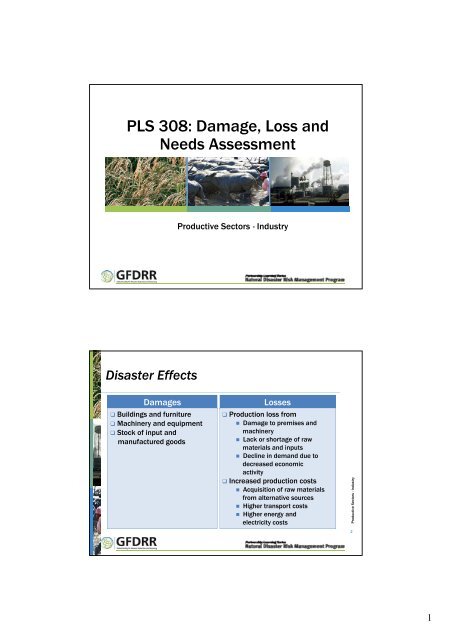PLS 308: Damage, Loss and Needs Assessment - Pacific Disaster Net
PLS 308: Damage, Loss and Needs Assessment - Pacific Disaster Net
PLS 308: Damage, Loss and Needs Assessment - Pacific Disaster Net
Create successful ePaper yourself
Turn your PDF publications into a flip-book with our unique Google optimized e-Paper software.
<strong>PLS</strong> <strong>308</strong>: <strong>Damage</strong>, <strong>Loss</strong> <strong>and</strong><strong>Needs</strong> <strong>Assessment</strong>Productive Sectors - Industry<strong>Disaster</strong> Effects<strong>Damage</strong>s Buildings <strong>and</strong> furniture Machinery <strong>and</strong> equipment Stock of input <strong>and</strong>manufactured goods<strong>Loss</strong>es Production loss from• <strong>Damage</strong> to premises <strong>and</strong>machinery• Lack or shortage of rawmaterials <strong>and</strong> inputs• Decline in dem<strong>and</strong> due todecreased economicactivity Increased production costs• Acquisition iti of raw materialsfrom alternative sources• Higher transport costs• Higher energy <strong>and</strong>electricity costsdustryProductive Sectors - In21
ResourcesInformation Most recentindustrial census orsurveys Time series ofindustrialproduction <strong>and</strong>prices Data on small <strong>and</strong>mediumenterprises (SMEs) Gross domesticindustrial product,by branches ofactivitySources Ministry of Industries Ministry of Planning Statistical Office Industry Associations Chambers of SpecialIndustries Central BanksTeam Composition <strong>Damage</strong> assessment:civil or industrialengineers <strong>Loss</strong> assessment:industrial economists Field survey:specializedsurveyor company or agroup of trainedstudentsdustryProductive Sectors - In3<strong>Assessment</strong> Process2
<strong>Assessment</strong> StepsDevelop typology:■Large, medium, small <strong>and</strong> micro enterprises■ Agro-industriesObtain pre-disaster (baseline) information■ Static baseline on physical assets Type,■ Capacity, <strong>and</strong> Number of machinery, etcDynamic baseline on industrial production Annual, <strong>and</strong> Monthlycedures for <strong>Assessment</strong>Industrial Sector: Proc5<strong>Assessment</strong> Steps (Cont.)Field survey of disaster effectsDevelop post-disaster forecast• Calendar for repair or replacement of assets• Schedule for production recoveryEstimate damage <strong>and</strong> lossesEstimate impact on balance of payments <strong>and</strong> fiscal sectorcedures for <strong>Assessment</strong>Industrial Sector: Proc63
The Role of Field Survey <strong>and</strong> Interviews Field survey is essential to get an idea of disaster effects onassets <strong>and</strong> production capacity, as well as• To develop a typology of affected industries• To find out the possible difficulties in replacing specialized or largeequipment <strong>and</strong> technology (obsolete machinery, delivery times) Field visits to be complemented by meetings with industrialassociations to solicit their assistance in collectinginformation on:• Pre-disaster industry performance• <strong>Damage</strong> <strong>and</strong> losses sustained• Financial requirements for recovery/reconstructioncedures for <strong>Assessment</strong>Industrial Sector: Proc7Post-<strong>Disaster</strong> Sector PerformanceDevelop realistic schedule of repair <strong>and</strong> replacement ofassets, with special reference to specialized machinery <strong>and</strong>equipmentEstimate post-disaster performance based on• Calendar of staged recovery of production capacity (supply)• Possible constraints in raw materials <strong>and</strong> inputs (supply)• Calendar of recovery of dem<strong>and</strong>• Additional dem<strong>and</strong>s from disaster reconstructioncedures for <strong>Assessment</strong>Industrial Sector: Proc84
<strong>Loss</strong> Estimation Production losses depend on the time needed to repair <strong>and</strong>/orreplace equipment <strong>and</strong> machinery The loss estimation takes into account:• The pre-disaster production goals for each industrial establishment• The constraints related to potential shortage or non-availability of rawmaterials <strong>and</strong> essential inputs such as electricity or water• The decrease in dem<strong>and</strong> for industrial products due to overall decline ineconomic activities in the affected area• The possible increase in dem<strong>and</strong> for certain industrial products needed inreconstruction• Higher production costs fromIncreased cost of raw material <strong>and</strong> inputsPayment of overtime salaries to employeesTemporary need to rent equipment <strong>and</strong> machineryHigher electricity costscedures for <strong>Assessment</strong>Industrial Sector: Proc9Impact on Macro-variables BOP• Estimate the value of required imports in the sector due to disasterPurchase of raw materials <strong>and</strong> other inputs Acquisition of construction materials <strong>and</strong> equipment to repair <strong>and</strong> replaceassets• Estimate the value of traditional export not realized due to decline inproduction Fiscal Position• Estimate lower tax revenues due to lower industrial production <strong>and</strong>exports• In the case of Government-owned industries Estimate decline in revenues Estimate increase in operational expenditures Data collection <strong>and</strong> analysis usually done by a macro-economistcedures for <strong>Assessment</strong>Industrial Sector: Proc105
















